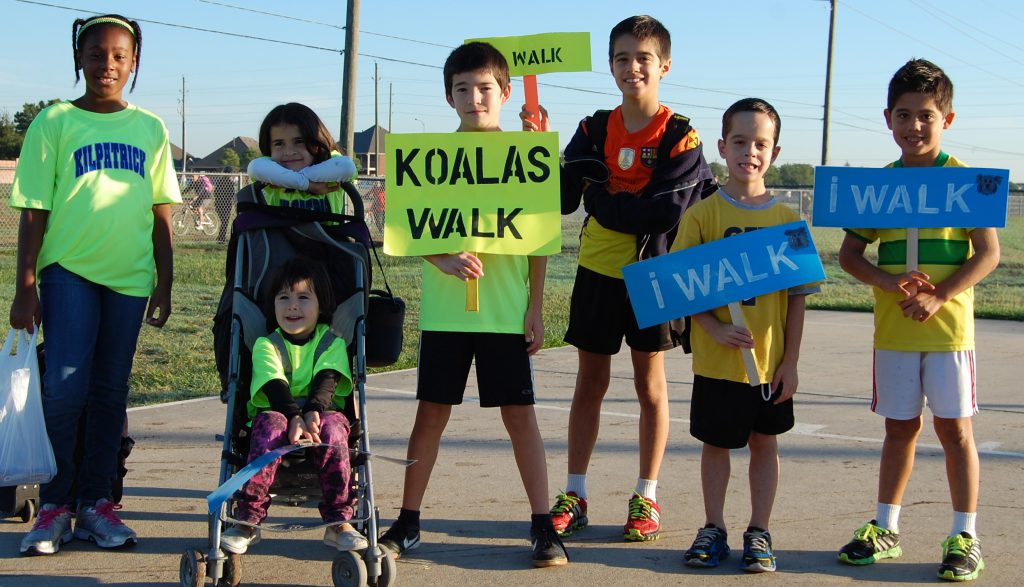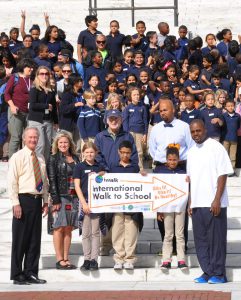Why Walk, Bike or Roll?
It’s fun! Remember the thrill of riding a bike for the first time or walking or rolling to school on the first day? There’s a feeling of joy and independence—a sense of adventure—that doesn’t fade. Of course, there are many other benefits to walking, biking or rolling to school, too.
Healthier Habits
Active trips to school enable children to incorporate the regular physical activity they need each day while also forming healthy habits that can last a lifetime. Regular physical activity helps children build strong bones, muscles and joints, and it decreases the risk of obesity. In contrast, insufficient physical activity can contribute to chronic diseases, such as diabetes, heart disease, cancer and stroke.

Odessa, Texas
The U.S. Department of Health and Human Services recommends that children and adolescents get one hour or more of physical activity each day. Research suggests that physically active kids are more likely to become healthy, physically active adults, underscoring the importance of developing the habit of regular physical activity early.
Cleaner Environment
When families decide to lace up their sneakers or strap on their helmets to get to school instead of riding in a car, they help reduce the amount of air pollutants emitted by automobiles.
Vehicles emit a variety of air pollutants, resulting in increases in ground-level ozone, nitrogen oxides and particulate matter such as particles of dust, soot, smoke, dirt and liquid droplets. To learn more about the health risks of pollution, visit www.epa.gov/urban-air-toxics.
Promoting Safety
In 2009, 203,000 children ages 15 and younger were injured in motor vehicles crashes; 15,000 of those injured were pedestrians (NHTSA, 2011). Priority must be placed on making it possible for everyone to walk & roll safely, especially in neighborhoods and school zones.
To reduce the risk of injury:
- Children and adults need to learn safe walking, biking and rolling skills.
- Drivers need to watch for others using the road.
- Safety problems along routes to school need to be fixed.
Some of the best ways to increase the safety of a child’s walking or rolling trip to school are to:
- Provide safe, well-maintained walkways separate from vehicles.
- Teach children to cross streets at marked crossings and to always look left-right-left.
- Slow traffic in neighborhoods and near schools through traffic calming strategies and enforcement efforts.
- Work with parents of children with disabilities and special education professionals to identify accessibility barriers.
- Ensure that walkways are continuous and meet or exceed national accessibility standards.
- Install curb ramps at every intersection and at mid-block crossings.
- Provide accessible pedestrian signals at intersections.
A note about personal security:
Parents and other adults sometimes worry about children encountering bullies or strangers on the way to or from school. Parents may fear kidnapping or assault. While the actual occurrences are extremely rare, it’s important to deal with both perceptions and documented problems and to create a plan that will minimize risk. Asking parents to walk with children to school is one way to address this concern. Some communities start walking school buses or bicycle trains as a way to have an adult presence on the street.
Community Benefits

Providence, RI
The whole community benefits from efforts to enable and encourage more children to walk, bike or roll to school safely. Benefits include:
- Less traffic congestion. According to the 2011 National Center for Safe Routes to School report, personal vehicles taking students to school accounted for 10 to 14 percent of all personal vehicle trips made during the morning peak commute times (based on National Household Travel Survey Data, 2009). Reducing the number of private vehicles commuting to school can reduce morning traffic around the school. Less traffic congestion also improves conditions for pedestrians and bicyclists, creating a positive cycle—as the community sees more people walking and rolling, more people feel comfortable walking and rolling.
- Stronger sense of community. The common goal of improving conditions for walking and bicycling brings families, neighbors, school officials and community leaders together. The sense of community also builds as children and parents develop walking and rolling buddies and chat with neighbors on the sidewalk or path.
- Safer streets. Communities with higher rates of walking and rolling tend to have lower crash rates for all travel modes. One reason may be that motorists drive more cautiously when they expect to encounter walkers and rollers. More walkers and rollers can also improve personal security by providing more “eyes on the street.”
- Lower costs. Encouraging and enabling active trips reduces costs for the family, community and school district. Families save on gas, communities spend less on building and maintaining roads and school districts spend less on busing. In fact, one school district calculated $237,000 in annual savings.
- Improved accessibility. Enabling students of all abilities to walk and roll to school makes it easier for everyone in the community to get around, including parents with strollers, senior citizens, residents without cars and residents with temporary or permanent mobility impairments.
- Economic gains. Sidewalks, paths and other investments in pedestrian and bicycle infrastructure can increase home values and direct additional traffic to local businesses.

